Evaluation of Low- and Intermediate-Temperature Performance of Bio Oil-Modified Asphalt Binders
Abstract
1. Introduction
2. Methodology
2.1. Preparation of the BMB Blends
2.2. Characterization of Aged DSO-BMB
2.2.1. Dynamic Shear Rheometer (DSR) Test
2.2.2. Bending Beam Rheometer (BBR) Test
2.2.3. Linear Amplitude Sweep (LAS) Test
3. Results and Discussion
3.1. Temperature Sweep Test Using DSR
3.1.1. Fatigue Parameter (G*sinδ)
3.1.2. Significance of Temperature and Oil Content on the Fatigue Parameter (G*sinδ)
3.2. Bending Beam Rheometer Test Results
3.2.1. Stiffness, and Low Temperature PG
3.2.2. Significance of Temperature and Oil Content on BBR Results
3.3. Linear Amplitude Sweep (LAS) Test Results
3.3.1. Shear Strain and Stresses
3.3.2. VECD Curves and Fatigue Behavior
3.3.3. Significance of Temperature and Oil Content on the LAS Parameters
4. Conclusions
- The results from the conventional tests showed that the penetration values increased, the softening point and the rotational viscosity both decreased with the addition of the bio-oil.
- The increase in the bio-oil content resulted in a decrease in the continuous PG. A PG of 58 was obtained when 2.5% DSO was added to the control asphalt binder.
- The fatigue parameter (G*sinδ) of the bio-oil-modified binder decreased at higher oil contents and temperatures, and this is considered an improvement since the maximum value in the Superpave system is 5000 kPa at the intermediate temperature range.
- The BBR results showed that the addition of bio-oil enhanced the low temperature performance, which leads to a better performance in cold climatic regions. The low PG of the bio-oil-modified asphalt binder at 5.5% DSO was −28 compared to −16 for the control asphalt binder.
- The fatigue resistance of the modified asphalt binder has been enhanced; this was explained by the increase in the Nf values obtained from the VECD theory.
- The temperature was more significant in affecting the different assessed parameters such as the fatigue parameter, stiffness, PG, and stresses compared to the oil content. However, the oil content was more significant in the results of the LAS test as obtained from the ANOVA tests.
- A DSO content of 1.5–2.5% was selected as the optimum value of bio-oil content to get the optimum fatigue and thermal cracking resistance while maintaining the high-temperature properties’ stability without adversely affecting them.
- The enhanced low-temperature and fatigue properties of the DSO-BMB obtained in this study are expected to enhance the performance of asphalt concrete in terms of low-temperature cracking and fatigue cracking as well.
- Additional DSR LAS tests and VECD analyses are recommended to be performed for the DSO-BMBs at different strain levels with multiple replicates.
Author Contributions
Funding
Institutional Review Board Statement
Informed Consent Statement
Data Availability Statement
Acknowledgments
Conflicts of Interest
References
- Hafeez, I.; Kamal, M.A.; Mirza, M.W.; Barkatullah; Bilal, S. Laboratory fatigue performance evaluation of different field laid asphalt mixtures. Constr. Build. Mater. 2013, 44, 792–797. [Google Scholar] [CrossRef]
- Canestrari, F.; Ingrassia, L.P. A review of top-down cracking in asphalt pavements: Causes, models, experimental tools and future challenges. J. Traffic Transp. Eng. 2020, 7, 541–572. [Google Scholar] [CrossRef]
- Lu, X.; Uhlback, P.; Soenen, H. Investigation of bitumen low temperature properties using a dynamic shear rheometer with 4 mm parallel plates. Int. J. Pavement Res. Technol. 2017, 10, 15–22. [Google Scholar] [CrossRef]
- Rahbar-Rastegar, R.; Dave, E.V.; Daniel, J.S. Fatigue and thermal cracking analysis of asphalt mixtures using continuum-damage and cohesive-zone models. J. Stomatol. 2018, 144, 1–11. [Google Scholar] [CrossRef]
- Gaudenzi, E.; Cardone, F.; Lu, X.; Canestrari, F. Analysis of fatigue and healing properties of conventional bitumen and bio-binder for road pavements. Materials 2020, 13, 420. [Google Scholar] [CrossRef] [PubMed]
- Ingrassia, L.P.; Lu, X.; Ferrotti, G.; Canestrari, F. Renewable materials in bituminous binders and mixtures: Speculative pretext or reliable opportunity? Resour. Conserv. Recycl. 2019, 144, 209–222. [Google Scholar] [CrossRef]
- Kowalski, K.J.; Król, J.B.; Bańkowski, W.; Radziszewski, P.; Sarnowski, M. Thermal and fatigue evaluation of asphalt mixtures containing RAP treated with a bio-agent. Appl. Sci. 2017, 7, 216. [Google Scholar] [CrossRef]
- Chailleux, E.; Audo, M.; Bujoli, B.; Queffelec, C.; Legrand, J.; Lepine, O. Alternative Binder from Microalgae; Number E-C165. Papers from a Workshop; Transportation Research Circular: Washington, DC, USA, 2012; pp. 7–14. [Google Scholar]
- Williams, R.C.; Raouf, M. Development of Non-Petroleum Based Binders for Use in Flexible Pavements Development of Non-Petroleum Based Binders for Use in Flexible; Iowa State University: Iowa, IA, USA, 2010. [Google Scholar]
- Wen, H.; Bhusal, S.; Wen, B. Laboratory Evaluation of Waste Cooking Oil-Based Bioasphalt as an Alternative Binder for Hot Mix Asphalt. J. Mater. Civ. Eng. 2013, 25, 1432–1437. [Google Scholar] [CrossRef]
- Yang, X.; You, Z. High temperature performance evaluation of bio-oil modified asphalt binders using the DSR and MSCR tests. Constr. Build. Mater. 2015, 76, 380–387. [Google Scholar] [CrossRef]
- Gong, M.; Zhu, H.; Pauli, T.; Yang, J.; Wei, J.; Yao, Z. Evaluation of bio-binder modified asphalt’s adhesion behavior using sessile drop device and atomic force microscopy. Constr. Build. Mater. 2017, 145, 42–51. [Google Scholar] [CrossRef]
- Samieadel, A.; Islam Rajib, A.; Phani Raj Dandamudi, K.; Deng, S.; Fini, E.H. Improving recycled asphalt using sustainable hybrid rejuvenators with enhanced intercalation into oxidized asphaltenes nanoaggregates. Constr. Build. Mater. 2020, 262, 120090. [Google Scholar] [CrossRef]
- Sun, Z.; Yi, J.; Huang, Y.; Feng, D.; Guo, C. Properties of asphalt binder modified by bio-oil derived from waste cooking oil. Constr. Build. Mater. 2016, 102, 496–504. [Google Scholar] [CrossRef]
- Yang, X.; You, Z.; Dai, Q.; Mills-Beale, J. Mechanical performance of asphalt mixtures modified by bio-oils derived from waste wood resources. Constr. Build. Mater. 2014, 51, 424–431. [Google Scholar] [CrossRef]
- Maharaj, R.; Ramjattan-Harry, V.; Mohamed, N. Rutting and Fatigue Cracking Resistance of Waste Cooking Oil Modified Trinidad Asphaltic Materials. Sci. World J. 2015, 2015. [Google Scholar] [CrossRef]
- Elkashef, M.; Williams, R.C. Improving fatigue and low temperature performance of 100% RAP mixtures using a soybean-derived rejuvenator. Constr. Build. Mater. 2017, 151, 345–352. [Google Scholar] [CrossRef]
- Alattieh, S.A.; Al-Khateeb, G.G.; Zeiada, W.; Shanableh, A. Performance assessment of bio-modified asphalt binder using extracted bio oil from date seeds waste. Int. J. Syst. Assur. Eng. Manag. 2020, 11, 1260–1270. [Google Scholar] [CrossRef]
- Podolsky, J.H.; Buss, A.; Williams, R.C.; Cochran, E. Comparative performance of bio-derived/chemical additives in warm mix asphalt at low temperature. Mater. Struct. Mater. Constr. 2016, 49, 563–575. [Google Scholar] [CrossRef]
- Foroutan Mirhosseini, A.; Kavussi, A.; Tahami, S.A.; Dessouky, S. Characterizing Temperature Performance of Bio-Modified Binders Containing RAP Binder. J. Mater. Civ. Eng. 2018, 30, 04018176. [Google Scholar] [CrossRef]
- Ingrassia, L.P.; Lu, X.; Ferrotti, G.; Conti, C.; Canestrari, F. Investigating the “circular propensity” of road bio-binders: Effectiveness in hot recycling of reclaimed asphalt and recyclability potential. J. Clean. Prod. 2020, 255, 120193. [Google Scholar] [CrossRef]
- Al-Omari, A.A.; Khedaywi, T.S.; Khasawneh, M.A. Laboratory characterization of asphalt binders modified with waste vegetable oil using SuperPave specifications. Int. J. Pavement Res. Technol. 2018, 11, 68–76. [Google Scholar] [CrossRef]
- Khan, J.; Hussain, A.; Haq, F.; Ahmad, K.; Mushtaq, K. Performance Evaluation of Modified Bitumen with Replaced Percentage of Waste Cooking Oil & Tire Rubber with Bagasse Ash as Modifier. Civ. Eng. J. 2019, 5, 587. [Google Scholar] [CrossRef]
- Lei, Y.; Wang, H.; Chen, X.; Yang, X.; You, Z.; Dong, S.; Gao, J. Shear property, high-temperature rheological performance and low-temperature flexibility of asphalt mastics modified with bio-oil. Constr. Build. Mater. 2018, 174, 30–37. [Google Scholar] [CrossRef]
- Alattieh, S.A. Evaluating the Performance of Date Seeds Bio Oil—Modified Asphalt Binders. Master’s Thesis, University of Sharjah, Sharjah, United Arab Emirates, 2020. [Google Scholar]
- ASTM D2872-19, Standard Test Method for Effect of Heat and Air on a Moving Film of Asphalt (Rolling Thin-Film Oven Test); ASTM International: West Conshohocken, PA, USA, 2019.
- ASTM D6521-19a, Standard Practice for Accelerated Aging of Asphalt Binder Using a Pressurized Aging Vessel (PAV); ASTM International: West Conshohocken, PA, USA, 2019.
- ASTM D7175-15, Standard Test Method for Determining the Rheological Properties of Asphalt Binder Using a Dynamic Shear Rheometer; ASTM International: West Conshohocken, PA, USA, 2015.
- ASTM D6648-08, Standard Test Method for Determining the Flexural Creep Stiffness of Asphalt Binder Using the Bending Beam Rheometer (BBR); ASTM International: West Conshohocken, PA, USA, 2016.
- AASHTO. Standard Method of Test for Estimating Damage Tolerance of Asphalt Binders Using the Linear Amplitude Sweep; AASHTO TP101; AASHTO: Washington, DC, USA, 2012. [Google Scholar]
- Teymourpour, P.; Bahia, H. Linear Amplitude Sweep Test. 2014. Available online: http://uwmarc.wisc.edu/linear-amplitude-sweep (accessed on 4 December 2019).
- Gao, J.; Wang, H.; You, Z.; Hasan MR, M.; Lei, Y.; Irfan, M. Rheological behavior and sensitivity of wood-derived bio-oil modified asphalt binders. Appl. Sci. 2018, 8, 919. [Google Scholar] [CrossRef]
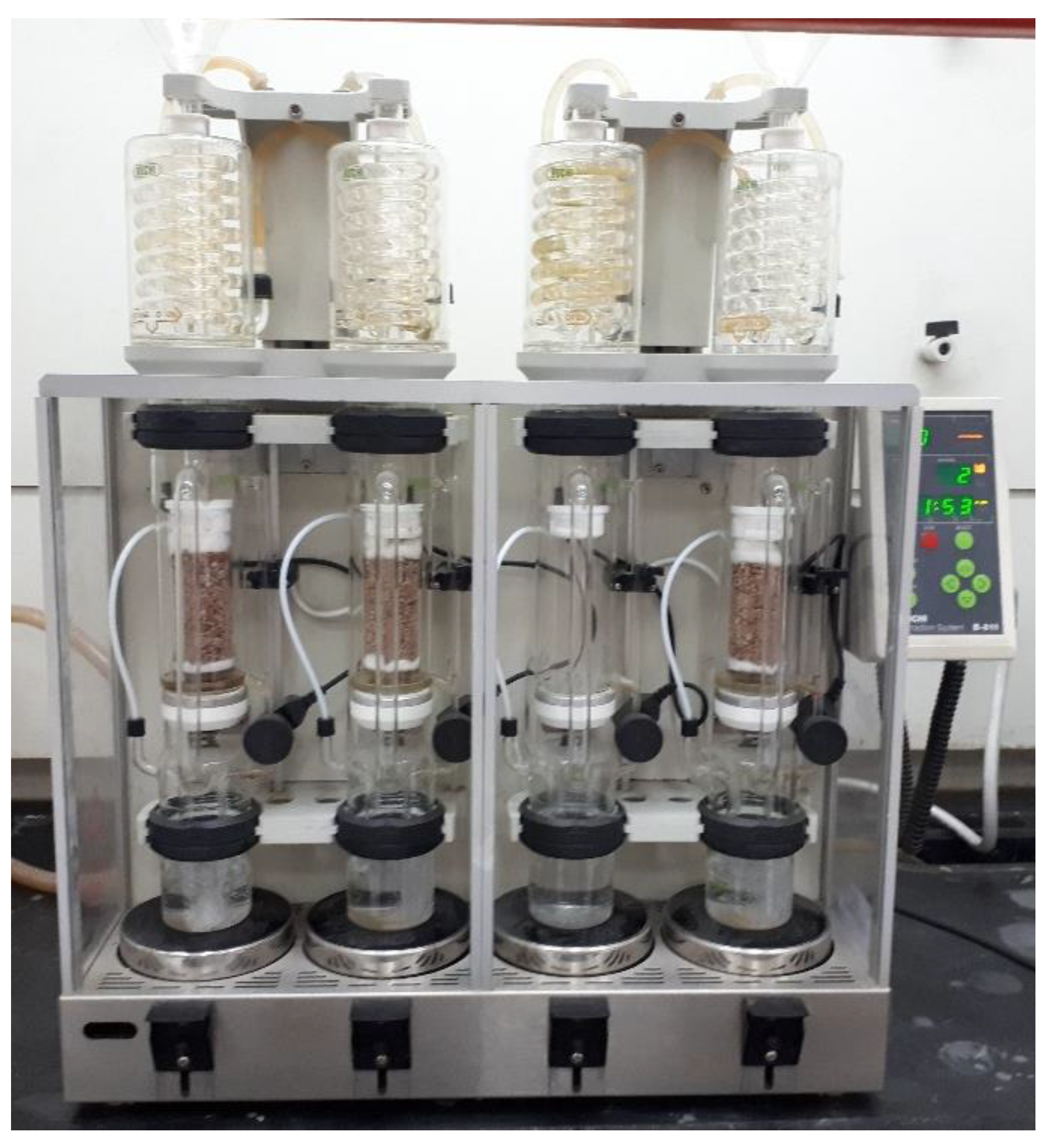
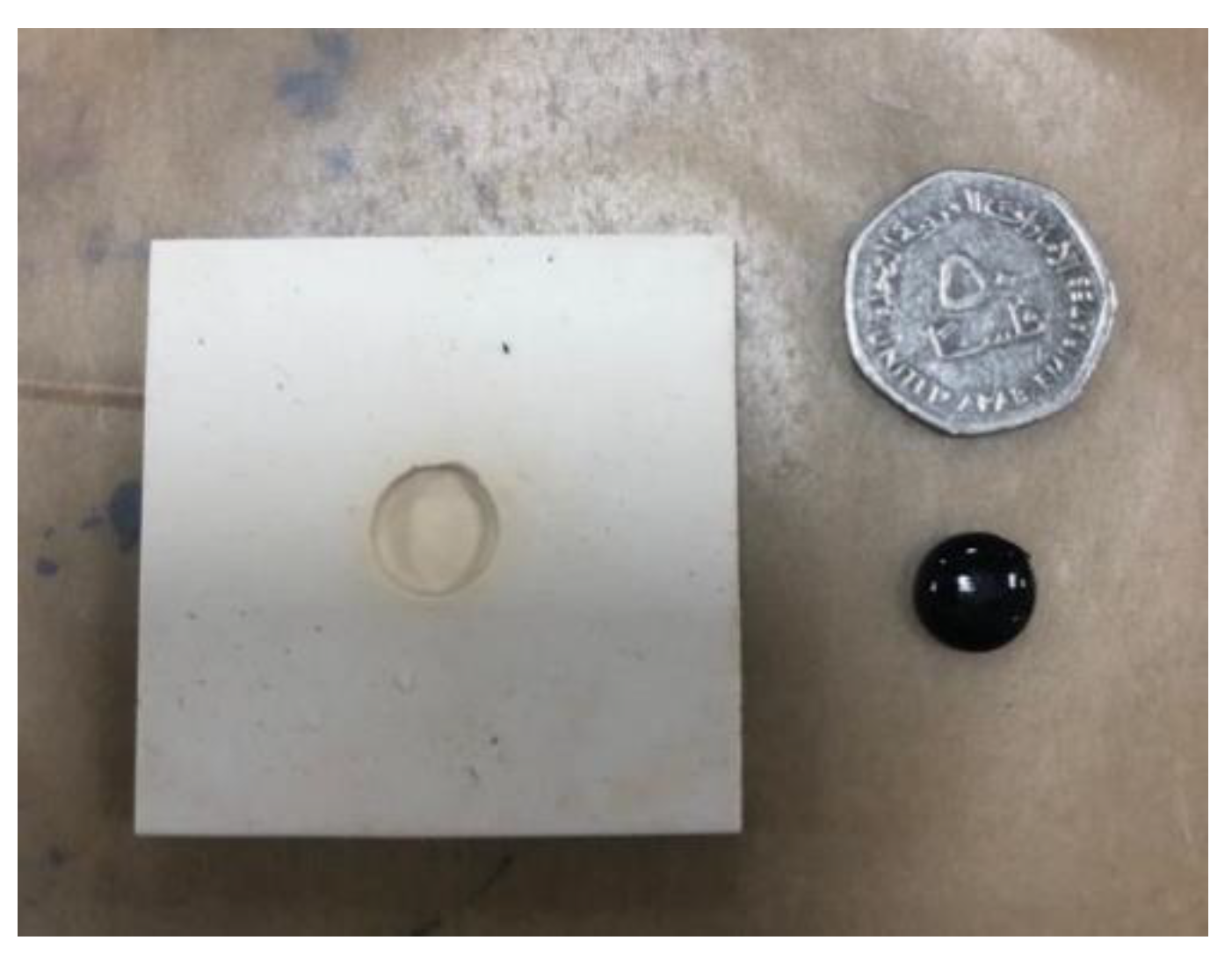
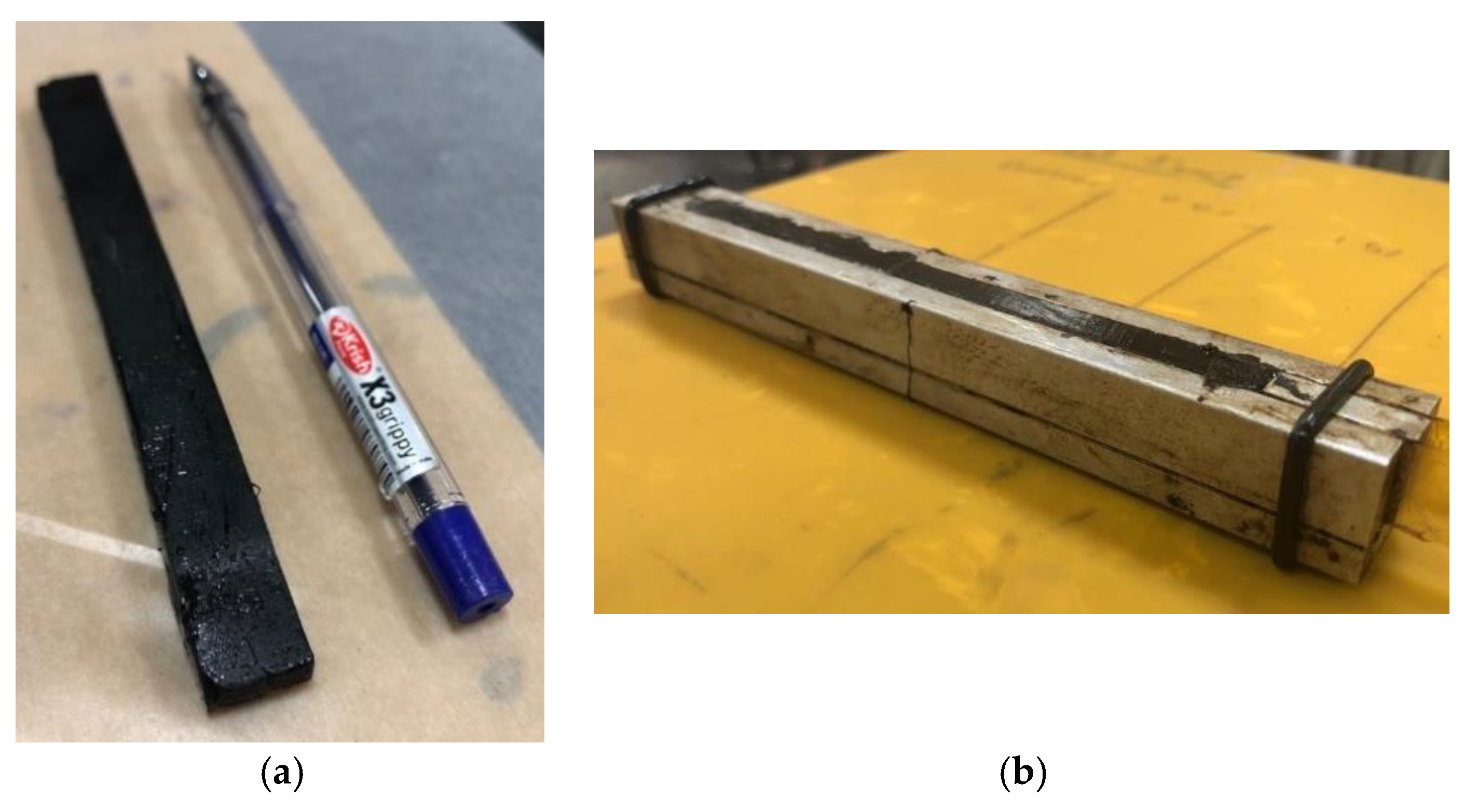

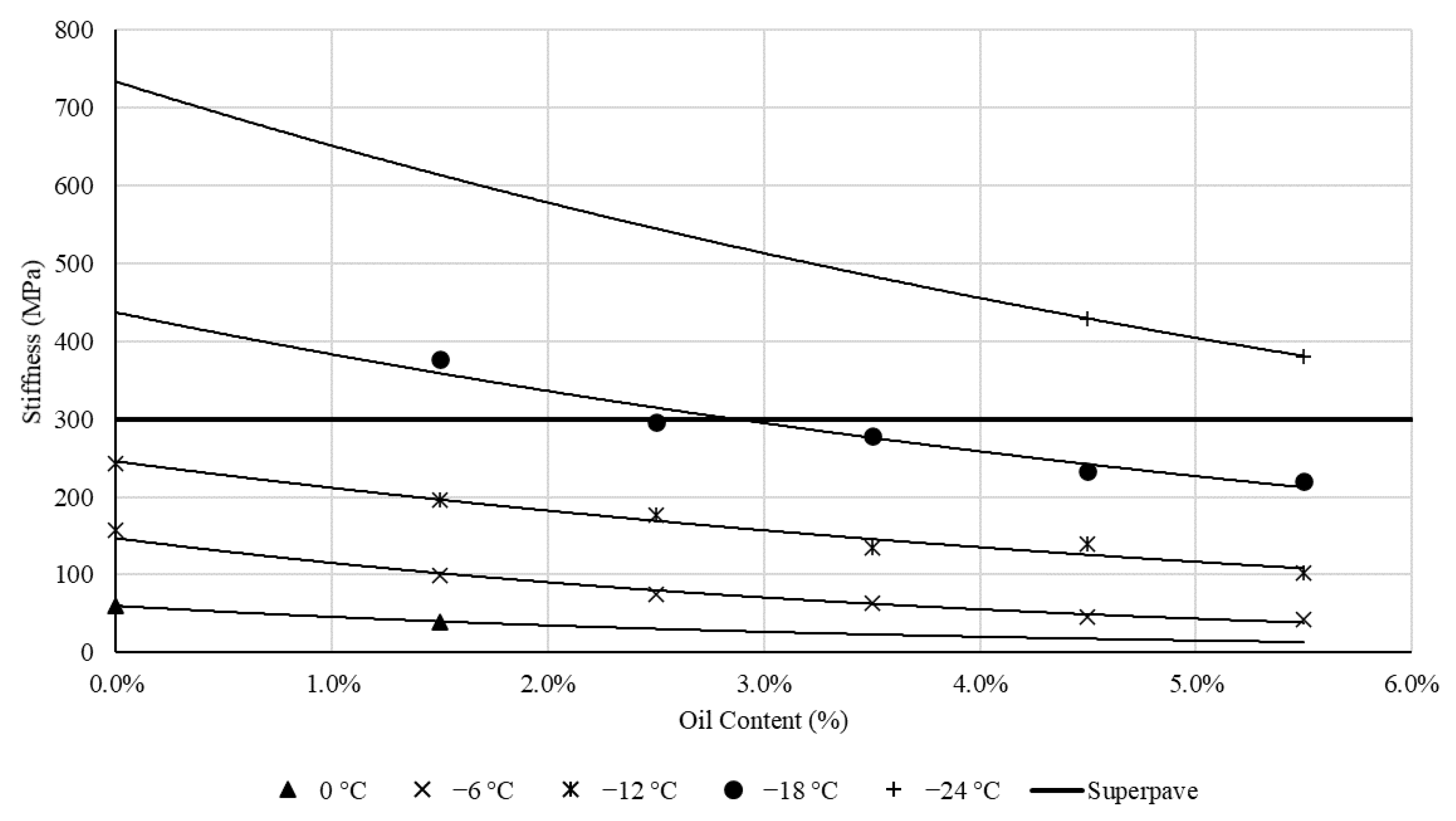
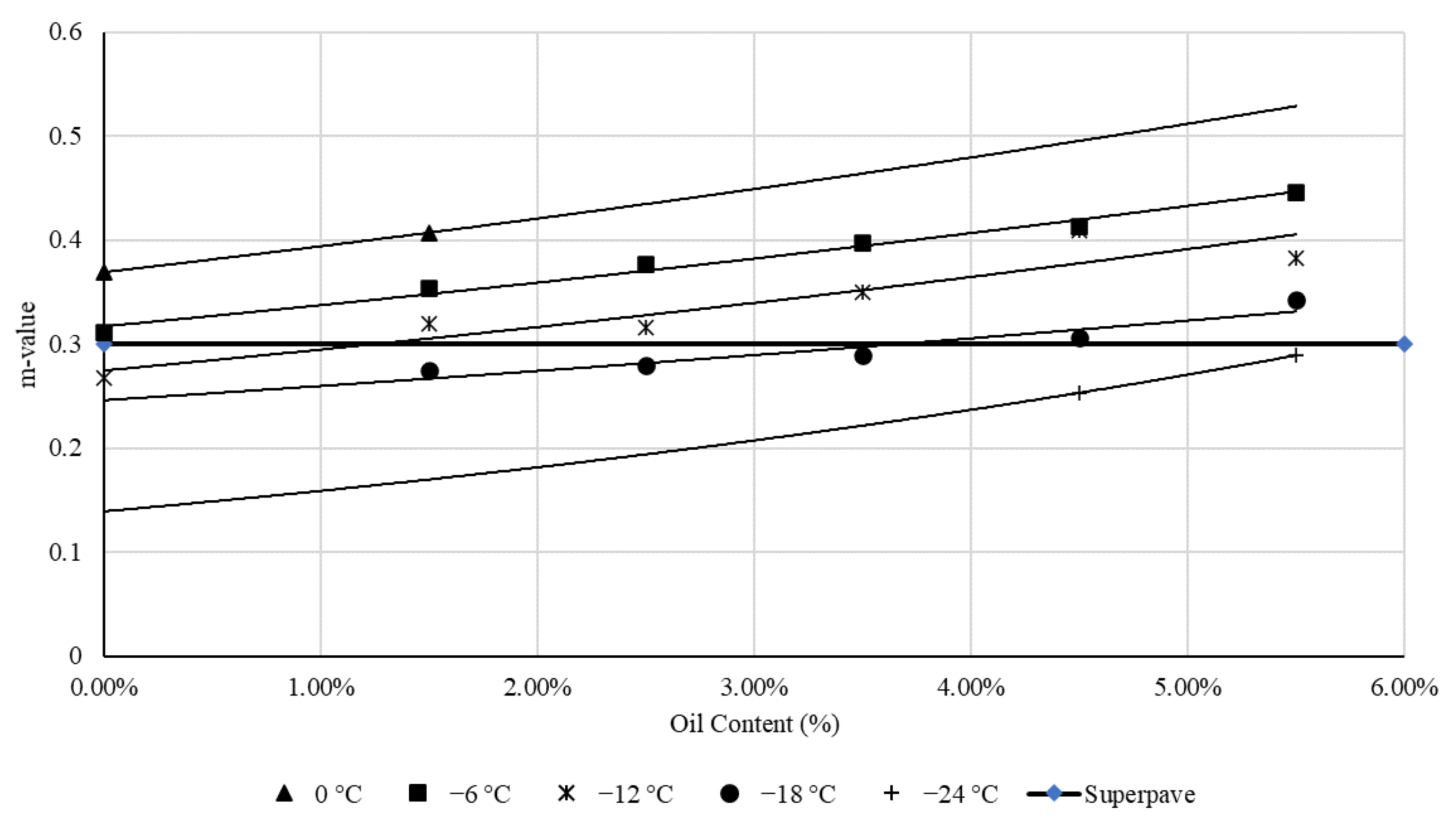
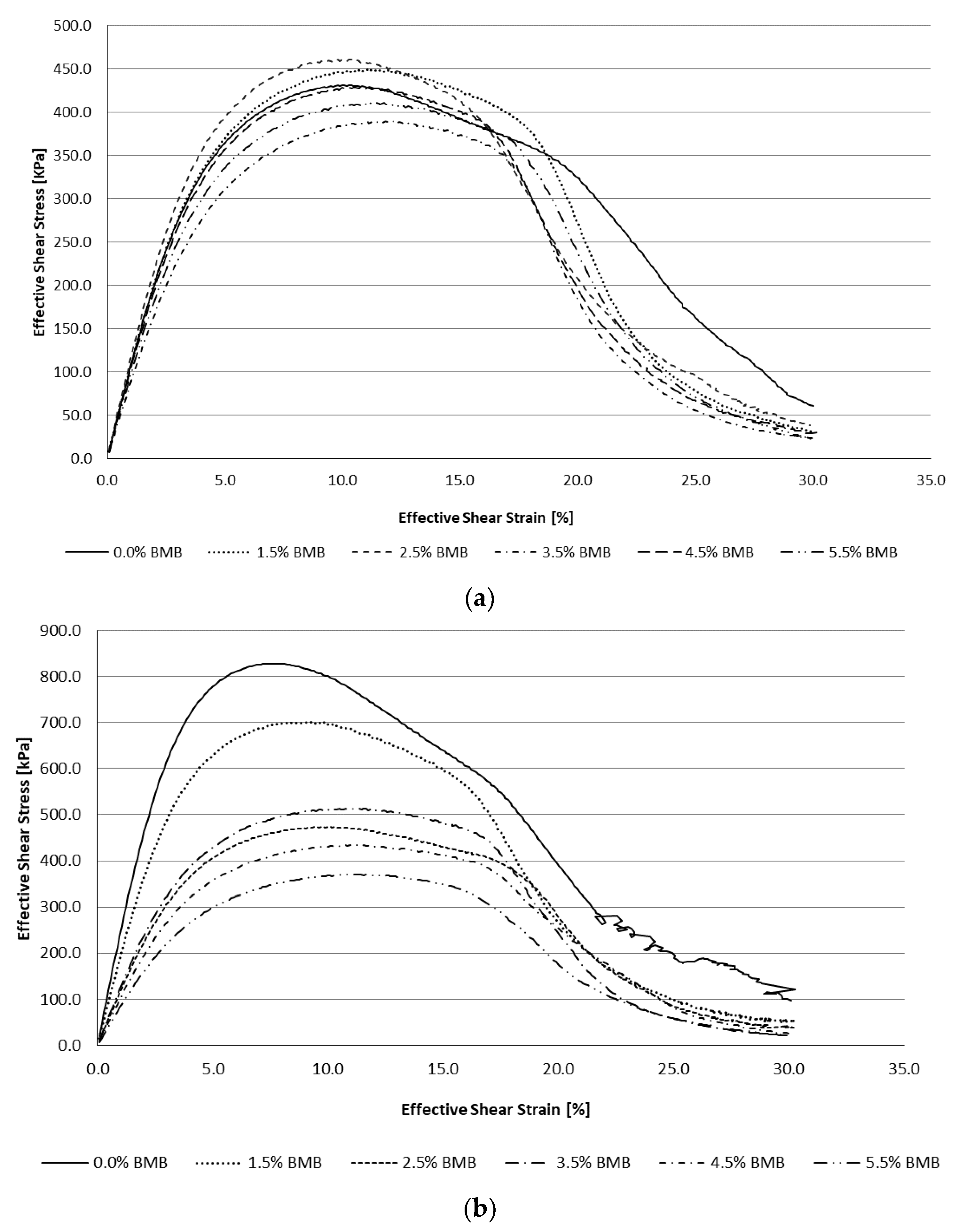

| Test | Standard Test Method | Temperatures (°C) | Obtained Parameter |
|---|---|---|---|
| DSR | ASTM D7175 [28] | 13–31 | |G*|sin δ |
| BBR | ASTM D6648 [29] | 0, −6, −12, −18, −24 | Stiffness, m-value |
| LAS | AASHTO TP101 [30] | Intermediate temperature and 20 | Df, Nf |
| Test Protocol | Parameter | Notation | Equation |
|---|---|---|---|
| Frequency Sweep Test | Storage Modulus | G’(ω) | |
| Alpha Parameter | α | ||
| Amplitude Sweep Test | Accumulated Damage | D(t) | |
| Complex Modulus Ratio | C(t) | ||
| Damage at Failure | Df | ||
| Fatigue Model Parameter 1 | A | ||
| Fatigue Model Parameter 2 | B | ||
| Number of Cycles to Failure | Nf |
| BMB Blend | Penetration @25 °C (dmm) | Softening Point (°C) | Rotational Viscosity @135 °C (Pa.s) | PG (°C) | Continuous PG (°C) |
|---|---|---|---|---|---|
| 0.0% | 54 | 49.93 | 0.583 | 64 | 67.40 |
| 1.5% | 66 | 49.75 | 0.381 | 64 | 64.83 |
| 2.5% | 84 | 45.03 | 0.323 | 58 | 63.16 |
| 3.5% | 102 | 43.5 | 0.323 | 58 | 61.54 |
| 4.5% | 117 | 42.38 | 0.298 | 58 | 59.95 |
| 5.5% | 139 | 41.03 | 0.263 | 58 | 58.41 |
| Model | Equation | R2 | ANOVA Test (p-Value) |
|---|---|---|---|
| Linear | 0.91 | OC: 5.74 × 10−10 T: 4.31 × 10−15 | |
| Nonlinear | 0.93 | OC: 7.69 × 10−15 LogT: 4.54 × 10−22 | |
| 0.97 | OC: 6.57 × 10−21 LogT: 7.62 × 10−29 |
| BMB Blend | Failed Criteria | PG (°C) | Intermediate Temperature (°C) | |G*|sinδ (kPa) |
|---|---|---|---|---|
| 0.0% | Temp: −12 m-value: 0.267 | 64–16 | 28 | 3226.25 |
| 1.5% | Temp: −18 Stiffness: 377.10 MPa m-value: 0.274 | 64–22 | 25 | 3330.10 |
| 2.5% | Temp: −18 m-value: 0.279 | 58–22 | 22 | 3915.77 |
| 3.5% | Temp: −18 m-value: 0.289 | 58–22 | 22 | 3095.91 |
| 4.5% | Temp: −24 Stiffness: 429.28 MPa m-value: 0.253 | 58–28 | 19 | 4732.19 |
| 5.5% | Temp: −24 Stiffness: 381.08 MPa m-value: 0.289 | 58–28 | 19 | 2604.02 |
| Parameter | Model | Equation | R2 | ANOVA Test (p-Value) |
|---|---|---|---|---|
| Stiffness | Linear | 0.94 | OC: 3.4 × 10−6 T: 4.5 × 10−13 | |
| Nonlinear | 0.98 | OC: 3.97 × 10−10 T:1.21 × 10−16 | ||
| m-value | Linear | 0.94 | OC: 2.87 × 10−10 T: 7.24 × 10−13 | |
| Nonlinear | 0.94 | OC: 6.1 × 10−10 T: 1.07 × 10−12 |
| BMB Blend | α | Nf @5.0% | Df |
|---|---|---|---|
| 0.0% | 2.04 | 1361 | 33 |
| 1.5% | 1.94 | 1224 | 33 |
| 2.5% | 2.02 | 1137 | 32 |
| 3.5% | 1.81 | 1441 | 38 |
| 4.5% | 1.98 | 1342 | 35 |
| 5.5% | 1.97 | 1478 | 36 |
| BMB Blend | α | Nf @5.0% | Df |
|---|---|---|---|
| 0.0% | 2.45 | 1079 | 28 |
| 1.5% | 2.17 | 1284 | 32 |
| 2.5% | 2.10 | 1159 | 31 |
| 3.5% | 1.99 | 1333 | 35 |
| 4.5% | 1.95 | 1351 | 35 |
| 5.5% | 1.93 | 1373 | 35 |
| Model | Equation | R2 | ANOVA Test (p-Value) |
|---|---|---|---|
| Linear | 0.65 | OC: 0.0013 T: 0.006 | |
| Nonlinear | 0.69 | OC: 0.0007 T: 0.0034 |
Publisher’s Note: MDPI stays neutral with regard to jurisdictional claims in published maps and institutional affiliations. |
© 2021 by the authors. Licensee MDPI, Basel, Switzerland. This article is an open access article distributed under the terms and conditions of the Creative Commons Attribution (CC BY) license (https://creativecommons.org/licenses/by/4.0/).
Share and Cite
Alattieh, S.A.; Al-Khateeb, G.G.; Zeiada, W. Evaluation of Low- and Intermediate-Temperature Performance of Bio Oil-Modified Asphalt Binders. Sustainability 2021, 13, 4039. https://doi.org/10.3390/su13074039
Alattieh SA, Al-Khateeb GG, Zeiada W. Evaluation of Low- and Intermediate-Temperature Performance of Bio Oil-Modified Asphalt Binders. Sustainability. 2021; 13(7):4039. https://doi.org/10.3390/su13074039
Chicago/Turabian StyleAlattieh, Sara A., Ghazi G. Al-Khateeb, and Waleed Zeiada. 2021. "Evaluation of Low- and Intermediate-Temperature Performance of Bio Oil-Modified Asphalt Binders" Sustainability 13, no. 7: 4039. https://doi.org/10.3390/su13074039
APA StyleAlattieh, S. A., Al-Khateeb, G. G., & Zeiada, W. (2021). Evaluation of Low- and Intermediate-Temperature Performance of Bio Oil-Modified Asphalt Binders. Sustainability, 13(7), 4039. https://doi.org/10.3390/su13074039








